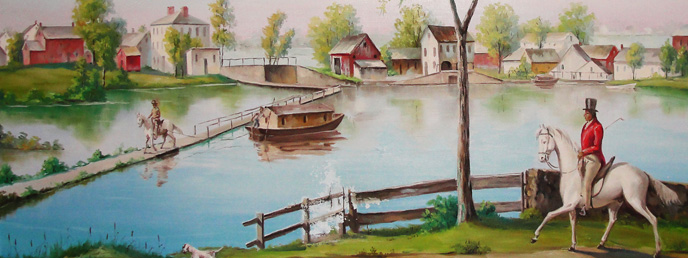


Middlesex Canal Association P.O. Box 333 Billerica, Massachusetts 01821
www.middlesexcanal.org
| Volume 59 No. 2 | February 2021 |
All I want for Christmas is a Roof!

Proposed Middlesex Canal Museum at 2 Old Elm Street - Summer of 2020.
Much had been accomplished during the summer months, but where is the roof?
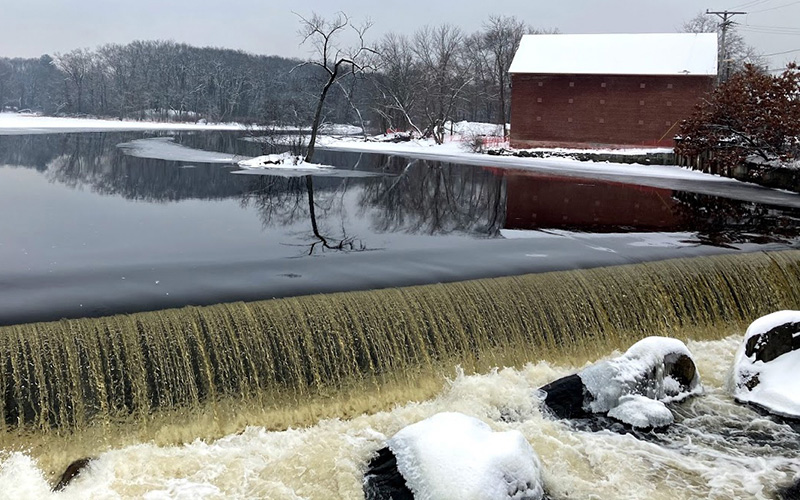
Future site of the Middlesex Canal Museum on December 23, 2020
The old roof was removed a year ago to accommodate the much-needed structural repairs. By late summer the repointing of the exterior brick walls was completed and the structural steel supports were installed. The building was sound and the red “X’ removed. Still there was no roof. A Halloween Eve snowstorm served as a reminder that winter was approaching. Would the new roof have to wait until spring? Once the materials were in hand neither a 12” mid-December snowfall, nor an ever present, persistent virus, could delay the workmen from their task. With the roof in place, work on the museum’s interior will now begin. When complete the new museum will cost over four times the original price of digging the entire canal. So far, the community has been supportive of the effort, but there is still much work left to be accomplished before the museum can open and as a result, donations to MCA museum project are welcome, urgently needed and much appreciated! Thank you.
Please mark your calendars
MCA Sponsored Events – 2021 Schedule
Winter Meeting, 1:00pm, Sunday, February 14 , 2021
Topic: video of Tom Dahill’s 2016 Valentine Day lecture
“Summit Pond: Middlesex Canal Circa 1822”
For ZOOM meeting instructions see www.middlesexcanal.org
Spring Walk: 1:30pm, Sunday March 21, 2021
Meet at Woburn Cinemas, 25 Middlesex Canal Park Drive, Woburn, MA
Spring Meeting: 1:00pm, Sunday, May 2, 2021
Topic: TBA
Details to be posted at www.middlesexcanal.org
Special Event: World Canal Conference
August 30 – September 3, 2021
Hosted by the Chesapeake and Ohio Canal Association
Hagerstown, Maryland
The Bicycle Tour South is dependent on the eventual schedule of the Lowell Line weekend trains. Details will be posted at www.middlesexcanal.org.
The Visitors Center/ Museum is open Saturday and Sunday, Noon – 4:00pm, except on a holiday (April 4, 2021 Easter).
The Board of Directors meets the 1st Wednesday of each month, 3:30-5:30pm, except July and August.
Check the MCA website for updated information during the COVID-19 pandemic.
TABLE OF CONTENTS
MCA Sponsored Events and Directions to the MCA Museum and Visitors’ Center
A Note of Appreciation from Russ Silva, MCA Treasurer
President’s Message by J. Jeremiah Breen
All I want for Christmas is --- a roof by Betty M. Bigwood
Kudos to Marlies by Betty M. Bigwood
Time Line by Betty M. Bigwood
The Passing of an Old Friend by Bill Gerber
Part II The Smallpox Cemetery by Alec Ingraham
Editors’ Letter
February, 2021
Welcome Readers to 2021!
It is hard to believe that it has been almost a year since we began sheltering in place from a virus. Through it all the Towpath Topics editors and contributors have continued to work to bring out each issue, and on time too!
Also hard at work have been the crew at 2 Old Elm Street. The last issue highlighted the people involved in the work, all prepared by Betty Bigwood, and in this issue, Betty has outdone herself with three articles; about what work has been done and the decision-making involved, publicity attempts; and a future time line for the project.
Sadly, this issue says goodbye to long-time MCA member Fred Lawson, contributed by Bill Gerber. Bill moved back to Pennsylvania since our last issue but has promised to continue working with the Association. Both will be missed.
Included, finally, is the second part of Alec Ingraham’s smallpox cemetery article. He highlights the families and follows the lives of the survivors. What is the lesson to be learned from the earlier epidemic?
Lastly, the president’s message, events, directions etc. are all included as usual. Ideas for articles and personal submissions are always considered, as well as complaints or praise!
One final request; please consider the MCA building fund if you win the lottery, don’t want your stimulus money, or just need a tax deduction. One day we will have a beautiful museum on the Concord River Mill Pond and all your donations can make it happen.
Sincerely,
Deb Fox, Alec Ingraham, Robert Winters
MCA Sponsored Events and Directions to Museum
The constantly changing restriction and requirements engendered by the pandemic might force changes in event venues or even cancellations. Anyone planning to attend or participate in the activities listed on the calendar of events should consult the MCA website at www.middlesexcanal.org for up-to-date information.
Special Event Invitation
from Bill Holdsworth
The Chesapeake and Ohio Canal Association is getting ready to welcome enthusiasts from around the world to next year’s World Canal Conference, August 30 – September, 2021 in Hagerstown, MD. The COVID-19 pandemic has cast a cloud over the preparations. Leipzig, Germany was scheduled to host the 2020 conference in September, but the impact of the pandemic forced them to reschedule for May, 2022.
We will monitor developments over the coming months. We are hopeful that conditions will improve and that canal lovers will be ready to gather again. We will be celebrating the 50th anniversary of the creation of the C&O Canal National Historic Park. Construction of the C&O Canal began in 1828 in Washington, D.C. The canal reached Cumberland in 1850. It operated until 1924. The federal government acquired the disused waterway in 1938. Legislation transformed it into a national park in 1971.
The Conference theme will be: Historic Canals Today Education, Recreation, and Tourism
Many 19th-century waterways have found a new role in the 21st Century. The conference will provide an opportunity to hear the secrets of their successes. Mornings of the four-day event will feature presentations related to the conference theme. In the afternoon, attendees will hit the road for study tours that visit canal locations and other local history sites, such as Great Falls, Paw Paw Tunnel, and Antietam battlefield. Hagerstown is just eight miles from the C&O Canal, making the city an ideal base for canal enthusiasts to explore the area. Conveniently located near the junction of two interstate highways, I-81 and I-70, Hagerstown is a 7½ hour drive from North Billerica. You can learn more by visiting the conference website, https://wcc2021.org/ or the Visit Hagerstown website: http://www.visithagerstown.com
Save the date. We would love to welcome you in 2021.
From: Bill Holdsworth
C&O Canal Association

Directions to Museum: 71 Faulkner Street in North Billerica, MA
By Car
From Rte. 128/95
Take Route 3 toward Nashua, to Exit 28 “Treble Cove Road, North Billerica, Carlisle”. At the end of the ramp, turn left onto Treble Cove Road toward North Billerica. At about ¾ mile, bear left at the fork. After another ¼ mile, at the traffic light, cross straight over Route 3A (Boston Road). Go about ¼ mile to a 3-way fork; take the middle road (Talbot Avenue) which will put St. Andrew’s Church on your left. Go ¼ mile to a stop sign and bear right onto Old Elm Street. Go about ¼ mile to the bridge over the Concord River, where Old Elm Street becomes Faulkner Street; the Museum is on your left and you can park across the street on your right, just beyond bridge. Watch out crossing the street!
From I-495
Take Exit 37, North Billerica, then south roughly 2 plus miles to the stop sign at Mt. Pleasant Street, turn right, then bear right at the Y, go 700’ and turn left into the parking lot. The Museum is across the street (Faulkner Street).
By Train
The Lowell Commuter line runs between Lowell and Boston’s North Station. From the station side of the tracks at North Billerica, the Museum is a 3-minute walk down Station Street and Faulkner Street on the right side.
A Note of Appreciation
As of Sunday, January 31, MCA supporters have donated $10,167 to the Annual Appeal including $1210 to the Endowment Fund and $4270 to the Building Fund.
As they did throughout the last year, some of our members who are often among the largest Annual Appeal contributors gave significant amounts directly to the 2 Old Elm Museum Building renovation project. Once again, others have stepped in with donations from ten to more than a thousand dollars and the total from the Annual Appeal is similar to that of recent years.
To date fifty-four individuals have contributed to the Annual Appeal and we thank them for it. Response has been a few days slower than last year, so if anyone else wishes to send a contribution to the Annual Appeal for the benefit of the Endowment Fund, the New Museum/Building Fund, or the “General” Fund for Current Expenses, our thanks go to them, too.
Russ Silva, Treasurer.
President’s Message – “Boston and Maine Landfill”
by J. Breen
The US EPA has mailed the Association a copy of its November 4, 2020 letter to the Massachusetts Historical Commission wherein the EPA states the remedial work planned for the Boston and Maine landfill (Area of Concern 1) near Pond St., Billerica, will not have an adverse effect on the “adjacent Middlesex Canal, which is listed on the National Register of Historic Places (NRHP) as part of the Middlesex Canal Historic and Archaeological District (the District). The section that borders AOC 1, between the south end of the B&M railroad yard (Iron Horse Park) and Pond Street, consists only of the prism and is listed as a contributing resource of the District. The section bordering AOC 1 still contains water, although the prism and berm are no longer visible.” The Nov 4 letter is EPA 3 in the appendix. But the location of the berm has not been established nor, of course, of the prism of which the berm is a part. Before declaring no adverse effect on the historical canal, the prism of the historical canal needs to be located horizontally and vertically. The present body of water is likely very different after 100 years of use by the railroad than the historical canal.
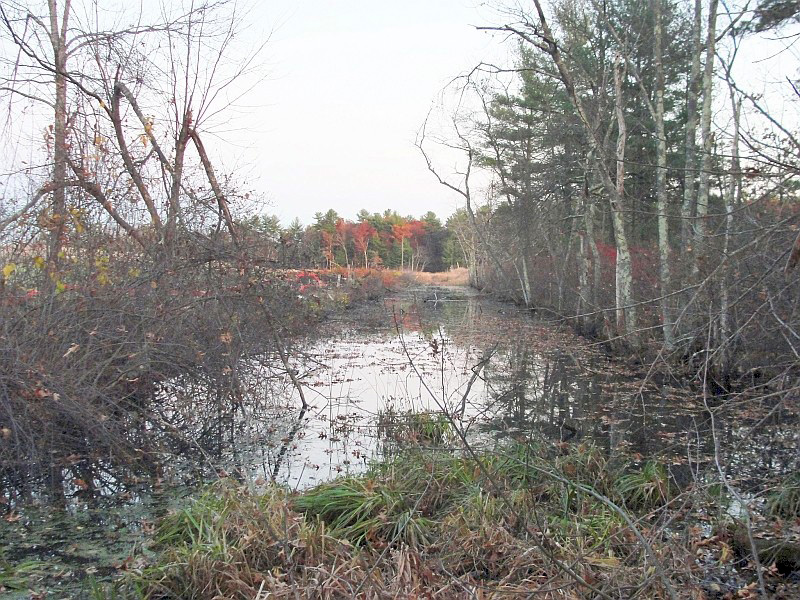
The Middlesex Canal from the railyard looking east to Pond St., Nov 2020.
Boston & Maine landfill, Area of Concern 1, Iron Horse Park, is on the left.
The approximate location horizontally of the prism can be estimated from the remnants of the canal between the rail yard and Pond Street but the vertical location is unknown until the elevation of a part of the prism is known. Looking at the canal now, you cannot tell where the prism is vertically in relation to the water.
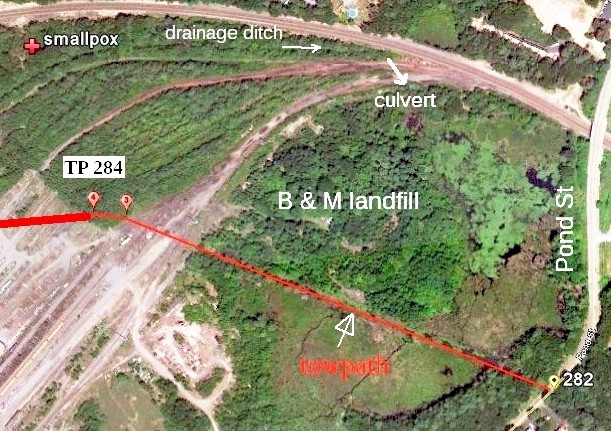
Middlesex Canal – 1829 survey on 2008 Mass GIS base
The Association commented in a letter to the Massachusetts Historical Commission on EPA’s conclusion that the proposed remedial work at the B & M landfill would not have an adverse effect on the canal. The Nov 25 letter is MCA-MHC in the appendix. The author argued that as the remedial work involved reconstruction of the north side of the canal, the reconstruction should be based on the Middlesex Canal prism in the National Register of Historic Places, i.e., 5’ berm and a 2-on-3 slope.
The Historical Commission recommended a conditional finding of no adverse effect. The two conditions are consultation with the Association and hiring of an industrial historian who would report to the Association. The Dec 15 letter is MHC-EPA in the appendix.
The “Assessment of Effects” referred to in the letters is EPA 1 in the appendix. The appendix is on line at:
http://www.middlesexcanal.org/photos/J%20Breen/appendix%20BandM%20landfill
Or copy and paste, https://tinyurl.com/1793sullivan.
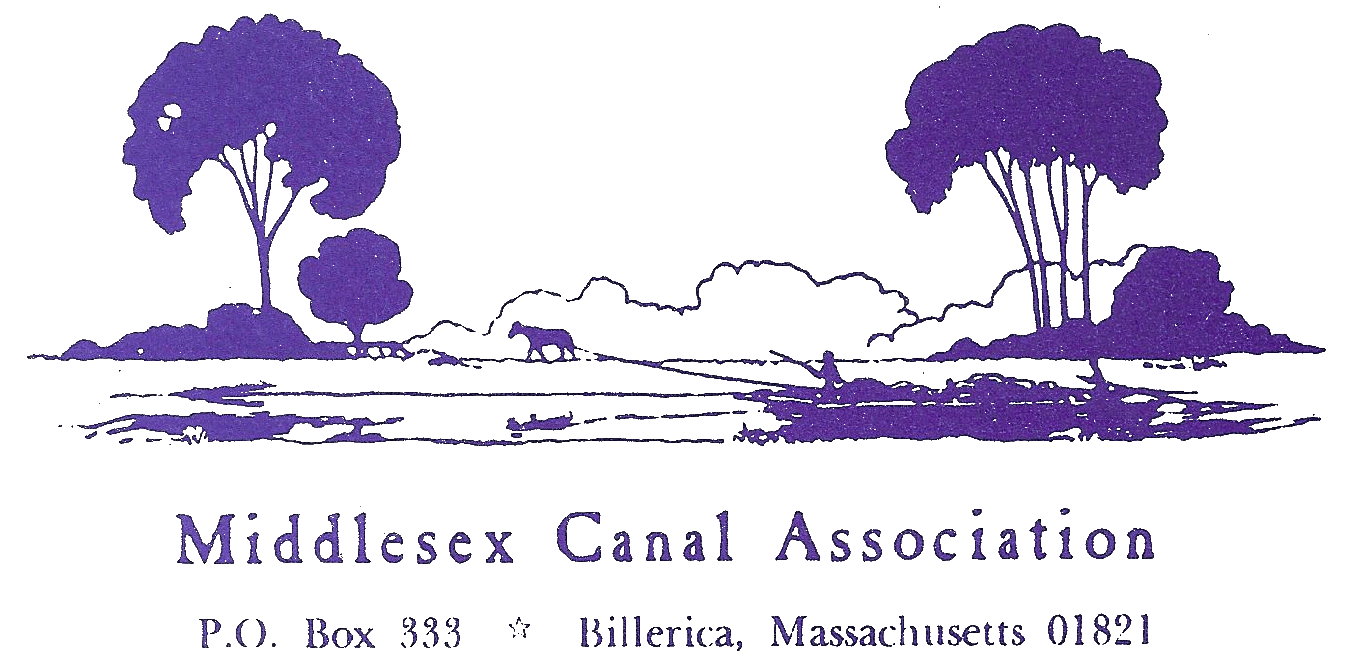
November 27, 2020
Ms. Brona Simon
SHPO and Executive Director
Massachusetts Historical Commission
220 Morrissey Boulevard
Boston, MA 02125
Re: Iron Horse Park Superfund Site, Billerica, Massachusetts
National Historic Preservation Act – Section 106 Consultation
Determination of No Adverse Effects for Remedial Action at B&M Railroad Landfill, Area of Concern (AOC) 1
Dear Ms. Simon:
“The exact height of the berm and towpath are not known.” Assessment, p. 8. Yet the assessment states the towpath or berm is high or low. “The width of the canal channel ranges from 25–45 feet . . .”, p. 3. The width of the water surface is what rain and the height of the beaver dam make it. Rather than guess, EPA should measure the towpath elevation south of mile 20, the S curve. See Assessment, Figure 5, p. 10. The towpath south of mile 20 is low fill, two or three feet, in a swamp. The path is solid having been compacted by the hooves of thousands tow horses and oxen. Measurement in a half dozen locations of elevation, width of towpath, and width to berm side, would provide the data for an accurate estimate of the canal between the railyard and Pond St before it was disturbed by the railroad company.
The 75’ width of the canal historic district as drawn on Figure 10, p. 18, of the assessment lacks the historic data of the 1829-30 George Baldwin survey. While the magnetic bearing, N 59½ W (Figure 4, p.9), of the canal is not relevant as the canal exists, the cross section of the canal (Figure 6, p. 10) has the measured width of the towpath as 6.50’ and a prism width of 104’. The surveyed line for the canal almost certainly was down the middle of the 1829 towpath, say 3’ from the waterside of a 10’ design towpath. Thus the 1829 survey line should be drawn on Figure 10, and the historic district lines drawn 22’ and 53’ south and north of the historic line.
When plotting the canal, best would be to
(1) note the true bearing of the canal using the magnetic deflection in 1829 of the line between the Bunker Hill monument and the State House in the Baker Library’s Middlesex Canal Field Survey Book,
(2) locate Turning Points 282 and 283, defining points of the linear canal between Pond St and the railyard, using grid coordinates, and
(3) note the elevation of the towpath on the standard North American Vertical Datum, NAVD 1988, with a conversion factor for the AMSL datum used in the assessment.
Whether the existing canal at AOC 1 has an as-built prism width of 104’ is dependent on the difference in elevation between the towpath and ground when built. Figure 10, p. 15, has profiles 3 through 6 but no indication that a purpose of them is to determine the cross section of the canal at AOC 1. They do not even transect the historic district. Cross sections of the historic district in the undisturbed part between AOC 1 and Pond St would be better locations for transects measuring the historic canal, indicating what was the historic canal at profiles 3 - 6. The transcribed “Section 2” from the 1829-30 survey in the notes to this letter shows how a section is done using the canal prism as a reference.
Under “Assessment of Effects”, p. 17, the argument is the canal at AOC 1 has been significantly altered . . . and need not be restored. The counter argument is that with significant grading to be done, Figure 10, p. 15, a typical 5’ wide berm with 2-on-3 slope into the water and up the hill be should graded as shown in “Section 2”, leaving the canal better than it was and historically accurate for the new hill.
Importance of Canal at AOC 1
In August 1794, the English engineer hired by the Middlesex Canal Company fixed the elevation of the water in the summit pond at one foot higher than the Richardson dam1, 2. In September 1794, the company began digging the canal between the Concord River summit pond and the Merrimack River. In 1798, the company replaced the Richardson dam. The river meadow owners in Concord, Sudbury, et al. are complaining that the dams at Billerica Falls are causing damaging floods with eventually a legislative committee holding hearings in 1859 and writing a 500 page report followed by an engineering report in 1861.3, 4 The most recent report on the summit pond and dam was on the removal of the dam to accommodate the reproductive cycle of diadromous fish.5 On the 200th anniversary in 2017 of Thoreau’s birth, a biography was published a major part of which was his involvement with the 1859 effort to remove the dam to benefit the meadow owners.6
The Richardson dam of 1794 to which the engineer fixed the water one foot higher in the summit pond is gone without its elevation recorded. However, that part of the Middlesex Canal between the Concord River summit pond and the Merrimack River was constructed after 1794 and before 1798 when the second dam was built. In other words, that part of Middlesex Canal was constructed with the one foot higher as its control elevation.
The canal between the summit pond and the Charles River, 107’ below the pond, was constructed after 1798. The canal descended the 107’ in steps through 16 locks. The first step was between the guard lock at the summit pond and the lock at Nichols’ Street, 4.4 miles towards Boston. The elevation of the towpath of the first step towards Boston when compared to the elevation of the towpath to the Merrimack River will indicate how much, if any, the pond was raised when the 1798 dam was built.
While the canal was 27 miles long, the 4.4 miles of the first step in the descent towards Boston has an elevation pertinent to the Great Billerica Dam Controversy7, and in that distance, only the canal on either side of Pond St. remains measurable. Spot elevations on berms and towpaths on the both sides which have different topography would produce data for calculating the elevation, xx.xx (NAVD88) of the historic towpath between the summit pond and Nichols’ Lock and at the disturbed AOC 1.
Very truly yours,
jbreen5@verizon.net, 978-688-4322
Notes
1. The Old Middlesex Canal by Mary Stetson Clarke 1974. Easton PA: Center for Canal History and Technology, 2nd printing, 1987. “Report of William Weston to the Directors of the Middlesex Canal”, August 2, 1794”, one foot higher”, p. 152. Clarke citation: Manuscripts Division, Baker Library, Harvard Business School, Baldwin Papers, Vol. 4.
2. “The Billerica Falls Dam” by J. Jeremiah Breen. Towpath Topics, Vol. 56, No. 2 (Jan 2018). http://middlesexcanal.org/towpath/towpathtopicsFeb2018.htm#BillericaDam
3. Report of the joint special committee upon the subject of the flowage of meadows on Concord and Sudbury Rivers, January 28, 1860. Boston: William White, printer to the State, 1860. Google Books, http://tinyurl.com/Jan1860report.
4. “The 1825 Iron Bolt” by J. Jeremiah Breen. Towpath Topics, Vol. 52, No. 1 (Sep 2013), pp. 8-10. https://tinyurl.com/y8qxbggq
5. Concord River Diadromous Fish Restoration: Feasibility Study: Final Report prepared by Gomez and Sullivan, Engineers, 2016. http://archives.lib.state.ma.us/handle/2452/626310
6. The Boatman: Henry David Thoreau’s River Years by Robert M. Thorson. Cambridge: Harvard University Press, 2017.
7. “The Great Billerica Dam Controversy” by Arthur L. Eno, Jr. Towpath Topics,Vol 20, No. 2 (Apr 1982). http://middlesexcanal.org/towpath/towpathtopicsApr1982.htm
A. The canal between the Concord and Merrimack Rivers is known as the Thoreau Towpath from Thoreau having boated on it and written of it in A Week on the Concord and Merrimack Rivers.
B. In 1828 a granite dam was built, submerging the 1778 dam. However, in 1825 an iron bolt was placed by the canal company as a benchmark for the use by the Faulkner Mill of summit water not needed for the canal. See Note 4, above. The 1825 iron bolt became a benchmark for measuring elevations on the dams and the Concord River.
C. “Section No. 2” by George R. Baldwin, 1830, on following page. Transcribed from the Internet Archive, Middlesex Canal Plan and Profile, copy of all nine cross sections with graphical scale, https://ia803003.us.archive.org/8/items/Middlesex_Canal_Plan_and_Profile/sections_linen_finish.jpg
D. Photo of “Middlesex Canal from railyard east to Pond Street” by J. Jeremiah breen, November 2020, on following page. N. B., the width of the canal at the water’s surface is uniform.
E. Link to October 30, 2020 Assessment of Effects and other files, Dropbox https://www.dropbox.com/sh/sext2euwuu1yku7/AAAW73wxqDXvsZJrRQEMFzIKa?dl=0
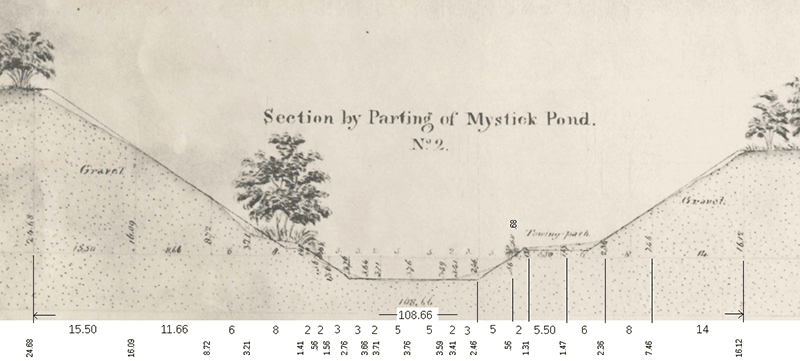
 All I want for Christmas is — a roof
All I want for Christmas is — a roof 
by Betty M. Bigwood
On Wednesday December 23, 2020 five Guatemalan roofers finished applying the last asphalt shingles and thereby gave us a gift we had wanted since February 2014 when we accepted another gift – an 1870 brick woolen store house – from Pace Industries. The primary goal of the Building Committee of the Middlesex Canal Association (the spirit of Thomas Raphael, President J. Jeremiah Breen, artist Thomas H. Dahill and Betty M. Bigwood) was to have a weather tight building. It was a long time coming. Finishing touches: the soffit and decorative fascia on the gable ends and eaves will await warmer weather to be completed.
While the site fulfills many of our wishes: next to the canal, on the banks of the Concord River at our summit pond which provided 90+ percent of the water for the canal, and next to the famous Floating Towpath, the site generated additional costs. It is less than a quarter of an acre in size and surrounded on three sides by water. By far the most expensive item was the need for cranes to carry construction materials over the canal area. At charges ranging from two to four thousand dollars a day it was costly. Twenty-five trusses were picked up and set on the south and north knee walls bolted to the bond beams at the top of the two long walls. (To accommodate stairs to the attic, plain rafters were used on the east [water] side.). Laddering was used to make a 1’ gable overhang. The bond beam – reinforced concrete – at the top of the gable and long walls, inside double walls, strengthened the building. The structural engineer reinforced the building to withstand a one-in-1000 year earthquake!
The original roof construction used queenrod trusses so the roof line at the eave ends needed knee walls (two by 12-inch boards separated by two-foot uprights) which allowed the trusses to rest two feet above the bond beam. The knee wall on the north side is two inches higher than the south wall to make the roof level. Our contractor, Bill Cogley, with years of experience made this seem a lot easier than it was.
Weather was usually not a problem except for two incidences. On one occasion a little snow, but high winds of up to 65 miles an hour, was forecast shortly after the trusses were installed. Not yet adequately braced, Contractor Bill Cogley was forced to put in some long days. Had he not done so, our trusses could have, in a domino effect, ended up on the ground as a pile of tangled toothpicks (a congeries). We breathed a sigh of relief when we saw them the next morning still standing. On December 17th, we had a major snow storm of 11-12 inches. We are not allowed to stock pile snow in a watershed area so it had to be removed from the parking lot. The inside of the building, had snow everywhere – every board, scaffold, ladder, truss, metal bracing had snow piled up on it several inches. All of this had to be brushed down, shoveled, snow blowed out – it must have been a beautiful sight but what a job and at considerable cost.
December 23, 2020 – with a new enclosed roof – is a very special date. Caveney Architecture and Collaborative – John Caveney, Christine McMahon, and Kevin Fitzgerald, sent three bottles of wine to celebrate the new roof. It was an elegant thing to do and much appreciated. (Tom and J are especially anxious to open them.)
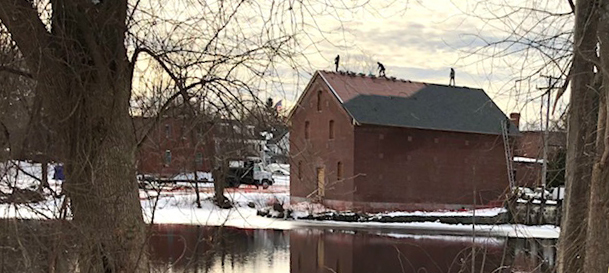
Roofers completing the final courses of shingles on December 23, 2020
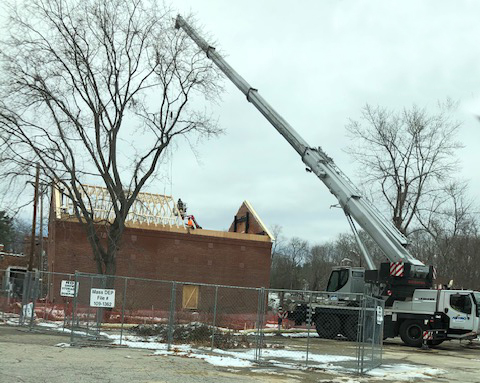
The ever-present costly crane hoisting the roof trusses into place
|
Kudos to Marlies
by Betty M. Bigwood
Marlies Henderson has a reputation for getting the job done. When we asked her for help with publicity about our building project she graciously answered in the affirmative. But, this time she outdid herself and we are so grateful!
Two articles have appeared in the Lowell Sun: both were front page spreads on June 30, 2020 and December 19, 2020. They are available online to the newspaper’s subscribers.
One positive development of this pandemic is that we have all learned to zoom. Marlies enticed an acquaintance to zoom over our building prior to having the trusses installed. It caused some excitement as the workers were quite anxious that it might go astray and cause them bodily harm as they were up 20+ feet high working. The video was sensational!
You can see it at https://www.facebook.com/WillyyPoundzZz/videos/
We had planned months ago to celebrate the final truss installation – a Topping Off Party – a Scandinavian custom to commemorate a milestone in construction when a small evergreen tree is tied to the top of last truss. It was not possible to celebrate with a party of food and bubbly during this pandemic. Marlies’s zoomer was under the weather so she asked Contractor Bill Cogley to take her up in the bucket of the crane – Some 50? feet swinging in the air holding on for dear life with one hand, and steadying her camera/phone with the other. The video was superb. Later Marlies settled on a still and added a fluttering American flag and an evergreen tree – there will never be a better virtual Topping Off Party picture.
Time Line
by Betty Bigwood
After starting work with a wide-open roof and plenty of light, the workers now had a new problem – complete darkness and no electricity. A generator and flood lights solved the problem.
In early January Contractor Bill Cogley removed the inside metal bracing. The roof added thousands of pounds to the structure and he wanted to be assured that all settled in place. Fourteen angle braces, each weighing ~200 lbs., were cut from the wide flange beams and lowered using a chain pulley hung from the rafters. Each rough end had to be ground down. It took a few days.
The next task is to install the floors for the attic and second floor. The first floor will remain dirt until after the sewer pump/line, grease trap, water and gas lines are brought into the building. Contractor Bill Cogley will have to construct a three-part wood bracing (two pieces of solid wood with a plywood core to meet the desired thickness) along the periphery against the metal flanges upon which they will attach the 2x6’s which hold up the plywood flooring. Rough stairs from the two floors will be constructed. He anticipates this will take 4-6 weeks until the end of February.
We are talking about windows, plans for the underground utilities, construction of the observation deck, bridge over the canal, vestibule, and required wetland plantings. There is much to do.
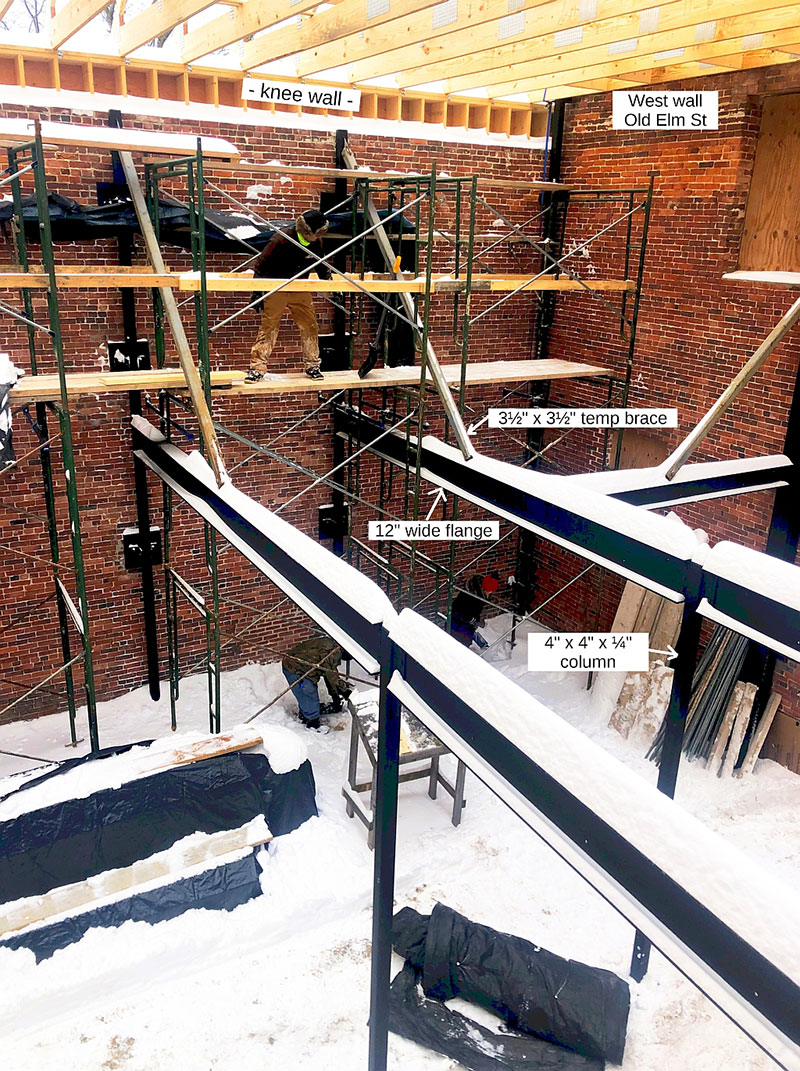
Bottom floor of 2 Old Elm Street on December 18, 2020 after a 12-inch snowfall
The Passing of an Old Friend - Fred Lawson
by Bill Gerber
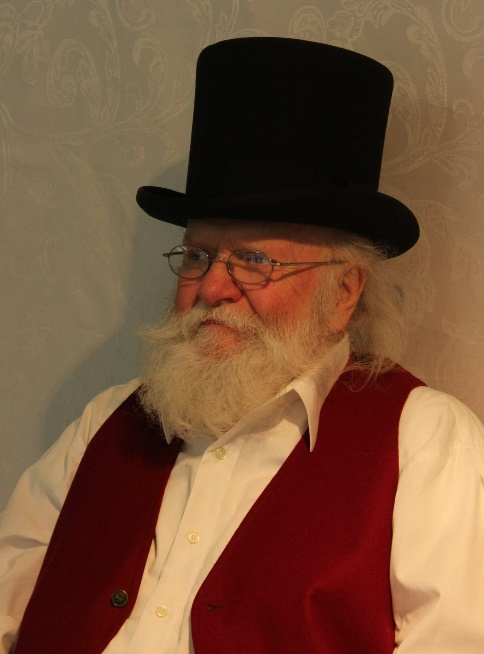 Fred died about a week before Christmas, he was a good friend. He had been in and out of hospitals and nursing homes for the past year or so, following a debilitating stroke that, regrettably, he never quite recovered from. His obit can be found at https://www.legacy.com/obituaries/bostonglobe/obituary.aspx?n=frederick-l-lawson&pid=197360710&fhid=6535. Cathy predeceased him, passing in April of 2012.
Fred died about a week before Christmas, he was a good friend. He had been in and out of hospitals and nursing homes for the past year or so, following a debilitating stroke that, regrettably, he never quite recovered from. His obit can be found at https://www.legacy.com/obituaries/bostonglobe/obituary.aspx?n=frederick-l-lawson&pid=197360710&fhid=6535. Cathy predeceased him, passing in April of 2012.
I met Fred and his wife Cathy about 45 years ago; we were all participating in ‘AEQ-75’, the bicentennial reenactment of Benedict Arnold’s 1775 expedition to Canada to capture Quebec for the American cause. Ben didn’t quite make it and, strictly speaking, neither did we! But we learned a lot, made some new friends, and generally had a lot of fun in the undertaking.
At some point in our travels through the wilds of Maine and southern Canada the subject of canals came up. A few years prior I had researched a small canal in Maine, then became aware of the very considerable number of canals that facilitated transportation in the early USA, as well as in other countries around the world. Fred, of course, was already heavily involved with the Middlesex Canal Association, of which he and Cathy were active charter members. Somehow I ‘got hooked’ and M’sex Canal research soon became a pastime, if not an obsession, for me too. In all of that, Fred was a mentor who guided my education, made resources available, and pointed out bits of knowledge that otherwise I’d never have become aware of.
Among the MCA founders, Fred had a unique ’schtick’; he had acquired several trays of glass slides, made decades earlier by similarly inclined amateur historians - Leon Cutler and Moses Wichter Mann - in the 1920s and 30s, along with a ‘Magic Lantern’ projector. With these, Fred and Cathy did presentations to groups of residents who lived near the canal, and many others too, to educate them about ‘the old ditch’. One of the outcomes of this was that some of the attendees offered up artifacts from the canal era; before long, Fred became the curator of a growing collection which soon grew to become a small museum.
(Many of the artifacts are listed in Towpath Topics; e.g., see “Canal Museum Grows”, http://middlesexcanal.org/towpath/towpathtopicsMar1965.htm; and still more followed thereafter)
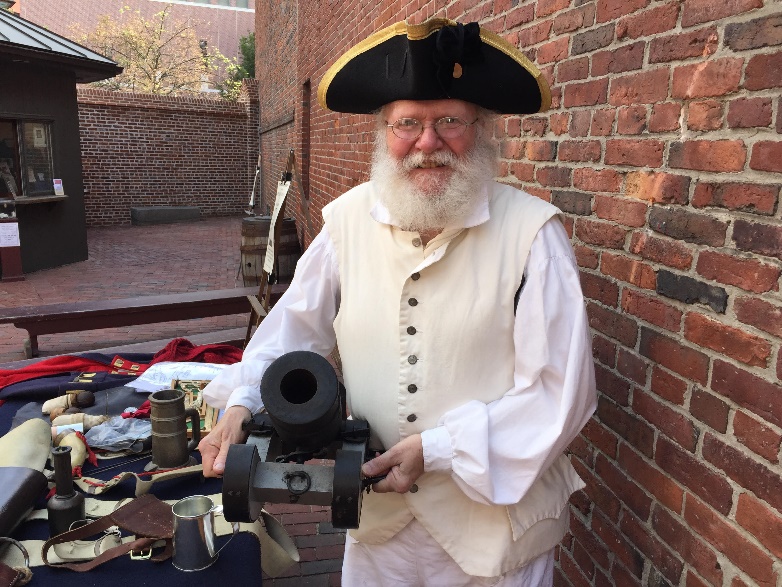
Pictures of Fred Lawson courtesy of his daughter, Zoe Lawson
But the M’sex was not Fred’s only interest. He and Cathy were pretty deep into the reenacting scene and were often off weekends to this fort or that battlefield, studying history by replicating it. Their chosen field was artillery, for which they and friends had assembled a minor arsenal of Revolutionary War era cannons. By association I learned to clean, swab, load, and fire a cannon, all ‘grunt-level’ functions, all while retaining my thumbs. On several occasions I was afforded the opportunity to accompany them, as an observer, when many similarly-inclined colonial artillerymen set up their cannons on Castle Island on the 4th of July, to fire the return salute to the USS Constitution during its annual ‘turn-around’; 21 guns from the Nation, 17 from the State, if I remember correctly.
There was a little reciprocity in this, of course. I recall that I bought a snow blower from Fred, and probably had my lawn mower repaired too. And when Fred and Cathy needed a new roof, they invited their friends and a great gaggle assembled; the job was done pretty much over a weekend. Sometime later, at a thank-you dinner, I recall commenting ‘Wow, Cathy, this dessert sure is chocolatey, what do you call it?’ ‘I call it a Chocolate Wow!’ Said she. Very fitting! I still have that recipe.
And there are so many more stories to tell. All wonderful memories … Goodbye, old friends, you will be missed. BG
Part II - The Smallpox Cemetery
by Alec Ingraham
Part I appeared in Towpath Topics, Volume 58; No. 2. As a consequence of the pandemic this issue was distributed only in electronic format.
The Railroad
It would seem from the date on the gravestone that it was installed in 1811. This is not the case. In 1829, when the Boston and Lowell Railroad was chartered, it was feared that the route of the rail line, which was to traverse Billerica north and east of the Center, would cut through the gravel mound where the small pox victims had been buried a score earlier. The Selectmen and the townspeople alerted the engineers in charge of the construction of the B & L and they able to convinced them that the gravesite should not be disturbed. My grandfather once told me that the large sweeping curve in the rail line between the Pond and High Street bridges was designed to accommodate this request. At least two articles in the Lowell Sun support his assertion.
On November 10, 1834, after the rejection of two previous requests, the Town Meeting approved a warrant article to erect a monument at the smallpox cemetery. A committee of three, Capt. Thomas Spaulding, Col. Josiah B. Richardson and Jonathan S. Bowers were dispatched to fulfill this task. In 1835, the Town settled the account at a cost of $20.00 reimbursing Col. Richardson for the purchase of the gravestone to mark the burial site. (Billerica Town Records Vol. X: Pages 132-133 and 152) Over the years the small footstones which once flanked the headstones have disappeared.
The Gravestone
The large 800-pound slate marker, which is 3” in thickness, 92” inches in height and 30” in width is pictured below:
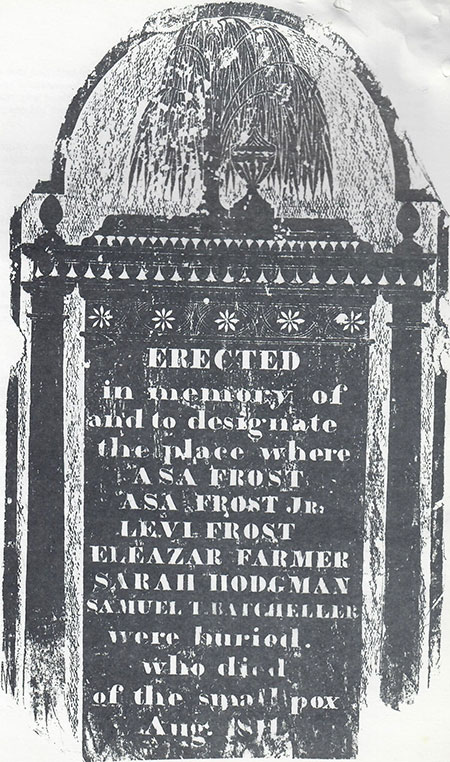 Gravestone rubbing from So Once was I … So You Will Be by Helen Lee Potter and Margaret B. Ingraham Done by Fifth Graders Chris Donovan and Bernie Hoar circa 1976 |
The inscription reads as follows: ERECTED |
A century after the epidemic crews leveling the area in preparation for the site of the Boston and Maine Railroad’s repair shops (located in Iron Horse Park off High Street in North Billerica) rediscovered the gravestone. The author of an article entitled “Interesting Century Old Grave is Found” in the August 19, 1911 issue of the Lowell Currier Citizen newspaper suggested that the small cemetery might require relocation, however, a November 12, 1911 article in the Boston Globe entitled “Long-Forgotten Grave, Smallpox Victims Buried in Billerica in 1811,” indicated otherwise.
The Records
It seems that the Town records tell a different story. The compassion exhibited by the townspeople was more than I had expected after having read the 1912 newspaper article. Both John Danforth and Josiah Trull (uncle of two of the victims and brother-in-law of another) were paid for nursing patients at the small pox hospital. John Parker was received compensation for supplying a bushel of limes, rye, and other sundries for the “pest house.” Cleanliness was very important. Thomas Richardson was compensated for supplying soap at the smallpox hospital and among other things cheese.
As the end drew near for some of the patients, Jacob Farrar was paid for building five coffins for the smallpox hospital (This probably supports Farmer’s reference in his history.). John Dyke, in a similar entry, drew payment for building a child’s coffin. It has always been thought with some certainty that one of the victims was a young child. Before the footstones disappeared, one was reported to be white signifying to many the death of a child.
The records reveal that John Dyke was paid for digging the grave of Asa Frost, Jr. They also suggest that John Danforth and Isaac French dug the remaining graves. One entry tells that Jacob Farrar was recompensed for making a “smoke” house for the smallpox hospital. There appears to be some suggestion that the epidemic was connected in some way with the neighboring town of Chelmsford, as other surrounding townships were not alerted.
The Town Meeting vote on Article #4 at the December 16, 1811 was in the affirmative and Joseph Batcheller, father of Samuel T. Batcheller, was awarded the sum of $36.00. Unfortunately, the records do not indicate that he availed himself of this compensation. It is interesting to note, however, that in 1812 the Middle Bridge was widened to 18’. Joseph Batcheller was paid in excess of $36.00 for his work on the bridge project. Was this the way his way of not receiving charity unless it was earned?
#4 To see if the Town will grant any relief to Joseph Batcheller respecting the expense of him and his family’s having small pox $36 to defray the cost of small pox. So voted.
Selected Excerpts from Town Records
September 2, 1811 To Thomas Richardson for ? bushels rye for the Pest House $2.25
September 23, 1811 Abatement for the tax year 1810 Asa Frost $5.97
September 23, 1811 To Jeremiah Blanchard for abatement of poll tax for Asa Frost (2) 1809 $5.84
December 10, 1811 To John Parker for sundries for Pest House and for Poor $67.51
December 16, 1811 To John Parker for bushels of limes for the Pest House $6.50
January 7, 1812 To B. Richardson for notifying Chelmsford about small pox $.55
January 7, 1812 To Joseph Locke for same $.50 January 9, 1812 To Timothy Davis for part pay for necessities and attendance at small pox hospital $20.00
January 9, 1812 To John Danforth for digging graves $2.00
January 9, 1812 To same for 4 7 days (?) nursing at small pox hospital $54.84
January 28, 1812 To Josiah Trull for 7 days nursing in small pox hospital $7.00
January 28, 1812 To Jacob Farrar 5 coffins for hospital $6.00
January 28, 1812 To same for making smoak house at the small pox hospital $2.50
January 28, 1812 To John Dyke for burying Asa Frost, Jr. $4.00
January 28, 1812 To same for making coffin for a child $1.25
February 24, 1812 To Isaac French for digging three graves $4.75
February 24, 1812 To Thomas Holden for Services at small pox hospital $2.35
February 24, 1812 To Dr. Jacob Kittredge for doctoring at poor and pest houses $1.50
February 29, 1812 To Thomas Richardson for cheese and soap for pest house $1.54
More Information
From the news items about the Small Pox Cemetery it appears that the marker remained relatively undisturbed until after its discovery by work crews in 1911. The small footstones that once graced the boundary of the site have disappeared and the large, slate gravestone, which was placed with care in 1835, has been used for target practice on many an occasion.
In July of 1966, several eight or nine-year-old lads dug up the grave site and toppled the stone. They removed some of the remains. Although a few of the bones fell prey to animals, the majority of them were placed in a rusted metal box and secreted in Mud Pond in Tewksbury. Fortunately, one lad became concerned that he might contract smallpox from exposure to the bones. He reported the desecration of the site to his parents. The Tewksbury and Billerica Police Departments investigated the incident. The metal box with the remains inside was reburied at the site, the hole filled-in and the gravestone righted. Before reinterment the bones, which included a skull, were tested and determined to be those of a 15 to 20-year-old male. Based on the ages of those buried at the site, these must have been the remains of Asa Frost, Jr. (Lowell Sun, July 16, 1966, “Mystery of ‘Gruesome’ Find in Tewksbury Solved” by Barbara E. Roundtree and Helen Harrington.)
In 1978, Boy Scout Troop #55, under the sponsorship of Honeywell Corporation, was registered by the Department of the Interior as the caretaker of the stretch of the Middlesex Canal from the Talbot Mills to Gray Street. The Scouts were responsible for maintaining the trails along the canal, filling in low spots, building bridges where needed, and cleaning up trash. Located in proximity to the Canal, the Scout Troop discovered the cemetery and felt compelled to see to the restoration of the gravesite. The area about the slate stone was excavated and a proper concrete footing was poured. Once reset this would prevent the marker from sinking into the soft earth. A cement apron was laid around the marker to keep weeds and small trees from obscuring it. The stone was cleaned and the graffiti removed. An article in the December 6, 1979 Lowell Sun entitled “Billerica Scout Troop Salvages a Long-Neglected Monument” reads:
Life scout Sean Doyle was in charge of the Canal cleanup in 1978 and decided, at that time, to develop a project for the improvement of the Smallpox Gravesite. He approached Cemetery Commissioner Andrew Bowen who obtained permission and support from the other Commissioners Frank Dignon and James Battcock. The Cemetery Department offered to supply the necessary funds, approximately $92.00, for the materials and granite plaque commemorating the restoration by Troop 55.
According to the article the dedication ceremony recognizing the Scout Troup’s effort took place at 10:00 A.M. on October 27, 1979. Father Joseph Beaudoin of St. Theresa’s Parish blessed the site. Dr Stearns, Town Historian, and well-known history enthusiast, Dr. Harriet Leach, spoke briefly about the history of the site and the development of the cowpox inoculations used before the smallpox vaccine was developed. Andy Bowen concluded the event with the presentation of certificates of appreciation to Sean Doyle, Scoutmaster Edmond Mahoney and others.
In an article in the June 12, 1930 issue of the Billerica News the location of the “pest house” is described. “Taking a right turn (heading along Salem Road from East Billerica) down Pond Street we pass the Middlesex Canal Railroad Bridge, take the first left on what was formerly Johnny Frost Road (Oak Street?) site of the Pest House of 1811.”
The bodies, reportedly, were buried on a mound in a vast, isolated swampy area owned by John Trull. He was a brother of Rhoda Frost, Asa’s wife, and of Hannah Batcheller, Samuel’s mother. It has been suggested that the site chosen was half way between the pest house and the Batcheller homestead, which was located on the present-day High Street where the solar farm is today or just north of the entrance to Iron Horse Park. Currently, this small cemetery is situated in a lightly wooded area near the northeast edge of a 41.7-acre parcel owned by BNZ Materials of 191 Front Street, Zelienople, PA. [See Billerica Assessor’s Map #16-43 and #17 (400 High Street)].
The Families
Life went on for those who survived the epidemic.
Asa Frost was born in Chelmsford, Massachusetts on March 13, 1767. He was the son of Ebenezer and Ester ______ Frost. Rhoda Frost was born in Billerica on May 31, 1759. She was the daughter of Samuel and Elizabeth ______ Trull. Rhoda and Asa would marry in Chelmsford on June 25, 1790. Asa and his family remained in Chelmsford where he paid taxes there at least until 1806. He first appears on the Billerica tax rolls the same year as a non-resident having paid his poll tax in Chelmsford. Why Asa and Rhoda moved to Billerica is not known. Rhoda’s father, Samuel Trull, was getting along in years and possibly she wanted to live in close proximity to his farm which was located on the south side of Sheldon Street near the Oak Street intersection. Asa would contract smallpox and pass away in August of 1811. He was 44 years old.
Rhoda Frost survived the smallpox epidemic. She is listed in the 1820 census as living alone in Billerica. The 1840 census lists her as living in Billerica (age 80 – 89). Residing with her is, given the times, a female (age 40-49). Could this individual be her daughter, Rhoda?
It would seem practical to assume that her younger children, in 1820, were living with the many kinfolks Rhoda had both in Billerica and in Chelmsford. There was a second connection between the families. Asa’s brother, Ebenezer, born in Chelmsford on December 16, 1770 married Rhoda’s sister, Olive born on December 6, 1769. They were married on April 15, 1794. Is there a reason of note or just happenstance? Jeremiah Blanchard, a well-respected citizen of Billerica, appeared in 1811 to be handling Rhoda’s affairs although there is no indication that this continued for a long period of time. Since a neighbor alerted authorities of Rhoda’s death she was quite possibly living alone. Rhoda died on September 23, 1849 at the age of 90 years, 4 month and 23 days. It appears from the records she never remarried.
Asa Frost, Jr., the couple’s eldest son, was born in Chelmsford on May 29, 1790. He was living with his parents in Billerica and would also succumb to smallpox in August of 1811. He had just attained the age of 21 years.
Like her mother, Rhoda Frost, the couple’s eldest daughter, was born in Chelmsford on August 12, 1794. She would survive the smallpox epidemic but never married. In 1850 she is found living with her aunt, Hannah Batcheller in Billerica. By 1860 she is living with her sister Hannah’s family in Charlestown. She would pass away there on October 22, 1861 at the age of 66 years, 2 months and 10 days of pleuritis.
Porter Frost and Hannah Frost were twins born in Chelmsford to Asa and Rhoda on August 1, 1802. Porter enlisted in the Army for five years on July 7, 1819. He claimed to be 22 years of age and was listed as a farmer from Chelmsford which gives credence to the thought that relatives helped support the family. He was assigned to the 6th infantry, Company K. On July 11, 1823, he was honorably discharged from Fort Atkinson in Nebraska. Hannah Frost would marry Phineas Bailey, a teamster, from Vermont. Although an official date is elusive, it appears the marriage took place in 1820. The couple would raise at least three children in Charlestown and are listed in that location on the 1850, 1860, and 1870 censuses. Phineas would pass away on October 4, 1880 in Somerville at the age of 78 years, 5 months and 25 days of heart disease. Hannah would follow on May 26, 1884 at the age of 82 years 10 months of senile dementia and old age.
Levi Frost was Asa’s brother, not his son as indicated in the newspaper. He was born on September 25, 1772. His name appeared on the tax list in Chelmsford until roughly 1805. At about the same time his name appears on the Billerica tax lists. Around 1800 he would marry Alice Jaquith of Billerica. The 1810 census indicates that he was residing in Billerica and the couple had two sons under the age of 10 and two daughters under the age of 10. Levi contracted smallpox and passed away in August of 1811 at the age of 39. The remainder of his family survived. Possibly he went to the aide of his brother when the epidemic hit or those affected attended a family gathering, however, the reason for his presence at Asa’s house is unclear. He may have contracted the disease and simply been housed there with the others so infected. Levi was living with his family in part of a house rented from the Proprietors of the Middlesex Canal. On the 19th of August 1811, John Langdon Sullivan, Superintendent of the Middlesex Canal questioned the Billerica Board of Selectmen as to the rental payments for the family’s living quarters. The Selectmen agreed that the Town would guarantee the rental costs until the Overseers of the Poor in Chelmsford saw fit to remove the family. Although living in Billerica, Levi Frost and his family were considered residents of Chelmsford, which may be a second reason why the Billerica Selectmen where anxious to notify their counterparts in Chelmsford of the small pox outbreak. In any event his wife Alice survived the malady and lived on. She did not remarry. Since Levi lived in Canal Housing, it might be suggested that he worked for the Proprietors in some capacity, although his name does not appear on any roster of employees. Could he have been exposed to the smallpox virus by incidental contact with a crew member of a canal freight boat or barge passing near his dwelling? An interesting speculation as to from whence came the virus that started the epidemic.
Unfortunately, not much is known about Levi’s family. A search of the vital records of Billerica and Chelmsford reveal very little. Levi’s son, also Levi Frost was born about March 22, 1806. On December 30, 1841 he would marry Lucretia Shipley of Groton, MA. She was the daughter of William Shipley, Jr. and Catherine (Nutting) Shipley. The couple would have one son. When the 1850 census was taken Levi and his family were living in Billerica, by 1855 they were in Groton until 1870, when they had moved to Pepperell and finally in 1880 in Acton. It was there that Levi would pass away from cancer on March 2, 1884. Levi had been a subsistence farmer for much of his life.
An exhaustive search of the records turned up little information concerning Levi, Sr.’s second son. Surprisingly, information about three of his daughters can be found in the vital records of Lexington, MA. The story begins with John Hudson who was born in Cohasset, MA on May 19, 1786. He was the son of Joseph and Elizabeth (Brown) Hudson. Although he was a successful Boston merchant selling clothes and accessories, he experienced many sorrows in his life. In March of 1808 he would marry Lucy Crocker and prior to her death in 1837, the couple would have four children none of whom lived beyond twenty years of age.
Their fifth child would die of a disease while serving in the Army in August of 1862. On April 21, 1838 he married Alice Frost, daughter or Levi and Alice Frost of Billerica. In 1843 the couple moved from Boston to Lexington. They had no children. There is a suggestion in the records that this was not only the second marriage for John but also for Alice, who died of consumption on November 7, 1867 at the age of 67 which would indicate she was born in 1800. Wasting little time, John married for a third time, on May 19, 1868, the 78-year-old John would wed the 57-year-old Mrs. Caroline (Frost) McIntire, Alice’s sister and the daughter of Levi and Alice Frost of Billerica. Caroline had married John McIntire of Needham, MA on March 13, 1836. John was the son of John and Caroline (Dewing) McIntire and was born on January 15, 1811 there. According to census records in 1850, John, listed as a trader, and Caroline along with their two children and a mulatto slave from North Carolina were living in Melrose, MA. Caroline presumably married John Hudson following the demise of her first husband. After the Death of John Hudson in 1874, Caroline (1880 census) moved to Oliver Street in Saint Joseph, Buchanan, Missouri. Here she was living with her son, John McIntire, from her first marriage, his wife Sarah and their six children. John was listed as an engineer by trade. John Hudson expired at the age of 88 on May 25, 1874. Caroline passed away of senile debility at the age of 90 at the Marion County Asylum in Wayne, Indiana. It should be noted that various official records list Caroline’s birth date at about 1811. If, indeed, she was born in that year, she would most probably would not have been included in the 1810 census. In this case she would have been Levi’s fifth child.
The 1850 census lists Susan Goodwin and three children from the Butters family as living with John in Lexington along with his wife, and yes, her mother and Levi, Sr.’s wife, Alice Frost. The children were the offspring of Sidney and Almira (Blodgett) Butters of Lexington, MA. Sidney was a successful carpenter and it is not clear why his progenies were living with the Hudson’s. Presumably, Susan Goodwin, who was 26 at the time, was the children’s aide. Is there a common connection among the Frost, Butters and Goodwin families?
Wait! Alice (Jaquith) Frost would live in John’s house until her death of old age and senile dementia on May 4, 1872 at the age of 91 years; 5 months. It appears that she never remarried following the smallpox epidemic. Her parents were listed as Aaron (of Billerica) and Alice (of Chelmsford) Jaquith. It would seem then that she was born about December 31, 1781. A search of the vital records is puzzling. Consistent with Levi’s background marriage records in Billerica and Chelmsford revealed nothing of import. Could her parents be misidentified on her death record? Could Alice Frost, born in Billerica on November 30, 1779, have married Levi. Her parents were Timothy (of Billerica) and Eunice [(Corey) of Chelmsford]? Possible but additional research is needed.
According to Massachusetts death records Clara Frost was born on September 3, 1803, in Billerica (possibly Chelmsford). She was the daughter of Levi and Alice Frost. On August 29, 1830, she married Charles Goodwin, the son of Thomas and Lucy (French) Goodwin of Billerica. Charles was born there on September 27, 1793. He was a carpenter by trade and had previously been married to Isabella Bowland (born ~1796). Charles and Isabella lived in Billerica. Born to them there were five children, 4 sons and 1 daughter. Isabella passed away on July 22, 1828 (Billerica Vital Records).
After their marriage Charles and Clara would continue to reside in Billerica as evidenced by the 1840 U.S. Census. They had two daughters, Clara Ann born on February 20, 1832 and Susan “Sussie” Ellen born two years later on February 15, 1834. Both were born in Billerica (Vital Records). Clara died, roughly five months shy of her 47th birthday on April 5, 1850 presumably in Billerica. After her death, Charles moved to Reading, MA and lived with Charles Henry Goodwin, a son from his previous marriage. Prior to his death on June 30, 1857 at the age of 63, he was listed as a cabinetmaker working in his son’s shop. Both Charles and Clara are buried in the South Cemetery in Billerica (Find a Grave).
On July 28, 1859, Clara Ann would marry George W. Cook, a cabinetmaker by trade, in Salem. He was born on October 9, 1834, the son of George F. and Priscilla Cook of Lynnfield, MA. The couple’s first and only child, Nellie was born in Salem on August 14, 1861. Approximately a year later, George enlisted in Company D, Massachusetts 50th Infantry Regiment. He was mustered out in 1863 and the following year would enlist again for a second hitch, in Company E, Massachusetts 1st Heavy Artillery Battalion, serving for another year. He held the rank of private. On December 13, 1892 he applied for his Civil War pension. The application listed him as an invalid, although this was not uncommon. By 1870 (Census) George and Clara Ann lived in Reading, MA on Spring Street. Clara Ann passed away from cancer on February 28, 1884 at the age of 52. George would continue his residence in Reading and died on February 10, 1917 at the age of 82. As he aged, he changed occupations from a cabinetmaker to bookkeeper. Their child, Nellie F. never married and succumb the following year on February 17, 1918. All are buried in the Laurel Hill Cemetery in Reading (Find a Grave). Susan Ellen never married. In 1850 she was living in Lexington in the home of John Hudson with her grand-mother and her aunt, presumably caring for the Butter’s children. By 1860, records suggest she was living in Reading, with the family of George W. Goodwin, likely a relative. She was recorded on the Census as a seamstress. By 1880, however, she was residing with George and Clara Ann. She is listed as a working in a shoe factory as a gluer. Even after her sister’s death she continued to live in the household of her brother-in-law, passing away from heart disease on November 18, 1902 at the age of 69. She too was buried in the Laurel Hill Cemetery in Reading (Find a Grave).
Captain Joseph Batcheller was born in Marblehead, MA on January 27, 1773 the son of Joseph and Elizabeth __________ Batcheller. On December 15, 1796 He would marry Hannah Trull of Billerica, Rhoda Frost’s sister. Hannah was born on July 12, 1773. In 1812, Joseph was commissioned a captain in the Massachusetts Militia by the then Governor Brooks and served in the war with England. He survived the small pox epidemic and passed away in Billerica on December 24, 1824 at the age of 51. His wife also survived and died on May 10, 1859 at the age of 86. The couple had eight children.
The eldest, Joseph Batcheller was born on Christmas Day in 1797. On September 6, 1819, in Boston, he enlisted in the Army for five years of service. He was assigned to the 6th Infantry; Company H. Following his discharge from the Army, he removed to St. Louis, MO. It would be interesting to learn if he and Porter Frost had previously discussed joining the Service. Josiah Batcheller was born on May 28, 1799 and married Olive Lyon in Boston on October 31, 1824. Josiah was a carpenter who lived for many years in North Reading, where he died at the age of 78 in 1877. The couple had a dozen children, 7 boys and 5 girls. Hannah Batcheller was born on October 28, 1800 and, on June 25, 1822, married James H. Eames of Reading, MA. She died in April of 1838. James was a blacksmith by trade. Two years later James married Abigail Flint. Sophronia Batcheller was born on May 20, 1802 and married, on May 18, 1825, William Tainter of Boston. He was the son of John Tainter of Boston and was born there on November 27, 1800. He was engaged in the mercantile business and operated a store on Milk Street. His partner proved untrustworthy and absconded with the funds leaving William in the hands of his creditors, whom he could not pay. Since he was no longer able to live the life to which he had been accustomed, he took to the bottle as they say. At Braman’s Bath, in 1834, allegedly on a dare, he dove into shallow water striking his head on the bottom of the pool causing his death. Two years later in 1836 Sophronia married Anthony Martis of Boston. She outlived Anthony and passed away in Boston at the age of 96 years; 2 months; and 5 days on July 25, 1896. It appears she had seven children in all, four with William and three with Anthony. Eliza K. Batcheller was born on February 20, 1804 and married David Hunt on January 30, 1830 in Wakefield. In 1850 the couple were found to be operating a farm in Mason, New Hampshire. Prior to her death, in Keene, New Hampshire, Eliza had nine children. She died of old age on December 5, 1892 at 88 years; 9 months; and 15 days. Samuel T. Batcheller was born on April 24, 1811 and presumably succumbed to smallpox on September 6, 1811. Could he have been named for his grandfather, Samuel Trull, who perished in 1810? This probably explains the need for the child’s coffin built by John Dyke.
Brooks Trull Batcheller was born on January 7, 1813. The route of the Middlesex Canal passed near the Batcheller homestead in North Billerica, which if you recall was located on present-day High Street close by the access road into Iron Horse Park. He began his working life as a towboy on the Middlesex Canal and would work his way up to become the captain of a packet boat. When service on the Canal was discontinued, he became a stage driver and later a stable keeper in Boston. An entry in the 1860/1861 Boston Directory listed under stables (livery) reads: Batcheller, B. T. 48 Devonshire. In 1867 he purchased a fine house in Lexington, MA. Seven years later he would be elected to a term in the State Senate. Brooks was additionally a member of the first Board of Trustees of the Lexington Savings Bank.
He married, on August 13, 1838, Rachel Campbell Dodge, who was born in Edgecomb, Maine on March 17, 1818. She the daughter of John and Rachel (House) Dodge. The couple had four children, all born in Boston, however, the 1855 State Census lists the family as living in Billerica. Brooks Trull died on August 21, 1902 at the age of 89, and Rachel on August 21,1907. Warren W. Batcheller was born July 26, 1815. He died of consumption on October 9, 1841 at the age of 26. He was a boatman and undoubtedly worked with his brother on the Middlesex Canal. (Batcheller Family History see Family Search website)
Eleazar Farmer was born in Chelmsford, the son of Simeon and Mary (Cory) Farmer on February 1, 1767. He is listed on the Chelmsford tax records, paying his poll tax only, at least until 1806. This might suggest, as Simeon’s oldest son, he was living and working on the family farm in Chelmsford. The 1800 census data also helps substantiate this hypothesis. Simeon Farmer of Chelmsford is listed as living with a male 26 to 45 years of age. Eleazar at the time was 33 years old. He and his father were the only two residents of the household, no women occupants were recorded. This would indicate that the male occupant was unmarried. In fact, no record has been found that Eleazar ever took a wife.
Why Eleazar was in Billerica at the time of the smallpox epidemic is a matter for conjecture. Eleazar was a contemporary of Asa Frost. Could they have attended the same common school in Chelmsford? Were they old friends? Was Eleazar paying a friendly visit or had he been summoned to Billerica to assist Asa with chores on the farm? The reasons will probably never be known. It is curious that Asa paid a poll tax for two people in Billerica in 1809 and again in 1810. At the time poll taxes were to be paid by all males over twenty-one years of age. Asa Jr. would not turn 21 until 1811. Could Eleazar been working as a farmhand in the employ of Asa Frost? The Town of Billerica took great pains to notify Chelmsford of the epidemic. Could this be a concerted effort to notify his aged father, Simeon? If Alice (Jaquith) Frost were indeed the daughter of Timothy and Eunice, by virtue of their parent’s marriages she and Eleazar may have been cousins which might explain further his connection with Billerica. So many mysteries remain….
Sarah Hodgman is even more of a mystery. The newspaper articles in 1911 paint her a heroine and claim she was born at the time of the Revolution. Clearly the first assertion is untrue. The Town Records indicate that the victims received care at the Town’s expense. Sarah’s name does not appear in the Town records. A further examination of the archives does not reveal the existence of a Sarah Hodgman who fits the newspaper description. The Family Search website https://www.familysearch.org. Beulah Hodgman indicated that Abijah Hodgman (1750-1825) of Carlisle, MA and Beulah Kibby (1753-1798) were married in Concord, MA on March 9, 1775 (note the time of the Revolution). The couple reared nine children, 2 boys and 7 girls. One of their daughter’s, Sarah was born about 1796 and died on August 16, 1811. An interesting coincidence? Beulah perished two years after her birth. On May 30, 1801, Abijah married Rhoda Sprake (Sprague) of Billerica. She was the widow of Isaac Sprake and the daughter of Seth and Mary Wilson. Rhoda was born in Billerica on June 20, 1764. This connection with Billerica does help some to explain Sarah’s presence. Could she have been wishing to escape the watchful eye of her step-mother? It is possible that the fifteen-year-old might have volunteered to help care for the newborn Samuel T. Batcheller? This is clearly speculation. There is a second connection which is revealed in Hazen’s History of Billerica. A Joseph Batcheller of New Ipswich, New Hampshire, on April 3, 1810, would marry a Rebecca Wilson. How much influence did this marriage would have on the situation in Billerica?

Death Notices from Page #2 from the Columbian Centinel #2856, Boston, Massachusetts, Wednesday, August 21, 1811
In Retrospect
John Farmer, in his Billerica Town history, indicates that fifteen individuals were infected with smallpox. When the tragedy struck, they were all tending to the chores of daily life. The horror, which interrupted their pastoral existence, marked many of those left behind. Yet, most who endured continued to live out their lives. It is difficult to know how the epidemic effected the survivors without a detailed statistical analysis for comparison. It is interesting to note, however, that many of the women married men who had previously been married. Some even never married while other victims had few children. The majority of those who succumbed to smallpox were male, 4 adults and one baby. Rhoda Trull and Alice Jaquith were nonagenarians and Hannah Trull was an octogenarian and neither Alice Jaquith nor Rhoda Frost remarried. Do these facts reveal anything? One note of import, it does appear that the Town followed the tenets of “the acts” passed by the Legislature in the 1790’s. Earlier I mentioned escaping from the Medical Associates Building in Lowell to avoid a smallpox vaccination. Since smallpox was not eradicated until 1977 (WHO), I guess I was fortunate that my mother and the nurse caught up to me that day in Prescott Street, many years ago.
Look How Much Has Been Accomplished!

This picture was taken in 2014 just after Pace Industries sold the building at 2 Old Elm Street in North Billerica to the Middlesex Canal Association for a nominal $1 cost. The proposed site for the new museum included one-tenth acre of land with water on three sides and a dilapidated building which was once utilized as a storehouse. At the time there were holes in the roof, vines growing up the sides of the building, and a sag along the ridge.
MISCELLANY
Back Issues - More than 50 years of back issues of Towpath Topics, together with an index to the content of all issues, are also available from our website http://middlesexcanal.org/towpath. These are an excellent resource for anyone who wishes to learn more about the canal and should be particularly useful for historic researchers.
Estate Planning - To those of you who are making your final arrangements, please remember the Middlesex Canal Association. Your help is vital to our future. Thank you for considering us.
Membership and Dues – There are two categories of membership: Proprietor (voting) and Member (non-voting). Annual dues for “Proprietor” are $25 and for “Member” just $15. Additional contributions are always welcome and gratefully accepted. If interested in becoming a “Proprietor” or a “Member” of the MCA, please mail membership checks to Neil Devins, 28 Burlington Avenue, Wilmington, MA 01887.
Museum & Reardon Room Rental - The facility is available at very reasonable rates for private affairs, and for non-profit organizations to hold meetings. The conference room holds up to 60 people and includes access to a kitchen and restrooms. For details and additional information please contact the museum at 978-670-2740.
Museum Shop - Looking for that perfect gift for a Middlesex Canal aficionado? Don’t forget to check out the inventory of canal related books, maps, and other items of general interest available at the museum shop. The store is open weekends from noon to 4:00pm except during holidays.
Nameplate - Excerpt from an acrylic reproduction of a watercolor painted by Jabez Ward Barton, ca. 1825, entitled “View from William Rogers House”. Shown, looking west, may be the packet boat George Washington being towed across the Concord River from the Floating Towpath at North Billerica.
Web Site – The URL for the Middlesex Canal Association’s web site is www.middlesexcanal.org. Our webmaster, Robert Winters, keeps the site up to date. Events, articles and other information will sometimes appear there before it can get to you through Towpath Topics. Please check the site from time to time for new entries.
The first issue of the Middlesex Canal Association newsletter was published in October, 1963.
Originally named “Canal News”, the first issue featured a contest to name the newsletter. A year later, the newsletter was renamed “Towpath Topics.”

Excerpt from an August 1818, drawing (artist unknown) of the steam towboat
Merrimack crossing the original (pre-1829) Medford Aqueduct,
probably on its way to service on the Merrimack River.
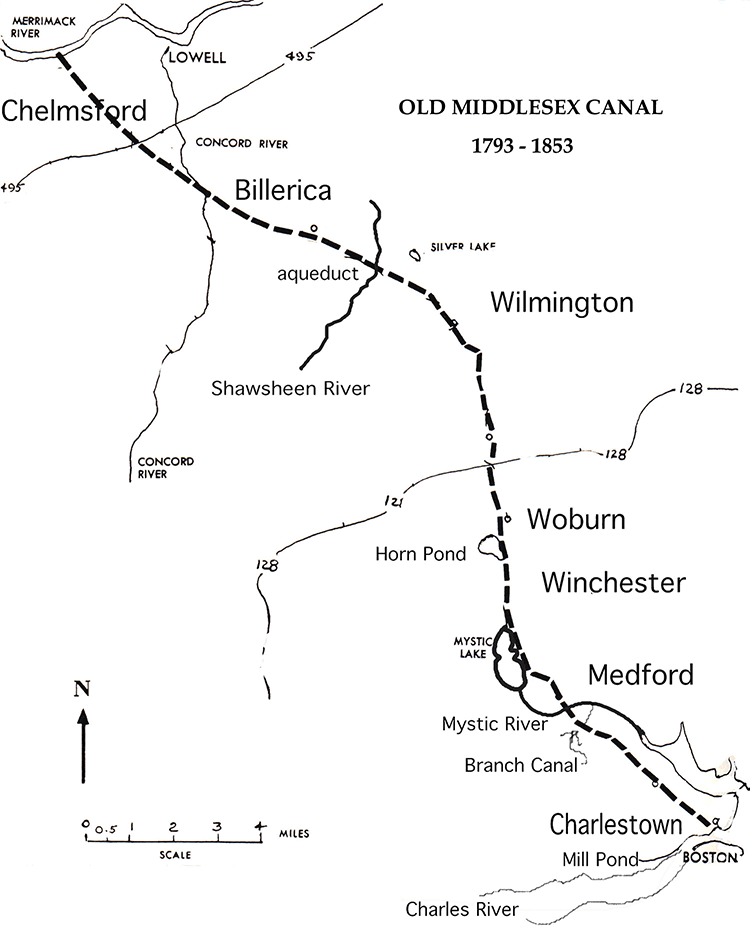
Towpath Topics is edited and published by Debra Fox, Alec Ingraham, and Robert Winters.
Corrections, contributions and ideas for future issues are always welcome.